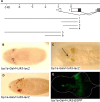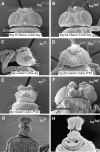The Drosophila Pax6 paralogs have different functions in head development but can partially substitute for each other
- PMID: 19484263
- PMCID: PMC2729988
- DOI: 10.1007/s00438-009-0458-2
The Drosophila Pax6 paralogs have different functions in head development but can partially substitute for each other
Abstract
There are two Pax6 genes in Drosophila melanogaster; eyeless (ey) and twin-of-eyeless (toy), due to a duplication, which most likely occurred in the insect lineage. They encode transcription factors important for head development. Misexpression of either toy or ey can induce formation of ectopic compound eyes. Toy regulates the ey gene by binding to an eye-specific enhancer in its second intron. However, Toy can induce ectopic eyes also in an ey( - ) background, which indicates a redundancy between the two Pax6 copies in eye formation. To elucidate to what extent these two genes are interchangeable, we first generated toy-Gal4 constructs capable of driving the Pax6 genes in a toy-specific manner. Genetic dissection of the promoter proximal region of toy identified a 1,300-bp region around the canonical transcription start that is sufficient to drive toy expression in embryonic brain and eye primorida and in larval eye-antennal discs. We find that exogenous expression of toy can partially rescue the lethality and eye phenotype caused by lethal mutations in ey and vice versa. We therefore conclude that Toy and Ey, to some extent, can substitute for each other. Nevertheless, the phenotypes of the rescued flies indicate that the two Pax6 genes are specialized to regulate defined structures of the fly head.
Figures





Similar articles
-
Functional divergence between eyeless and twin of eyeless in Drosophila melanogaster.Development. 2004 Aug;131(16):3943-53. doi: 10.1242/dev.01278. Epub 2004 Jul 14. Development. 2004. PMID: 15253940
-
Probing the Drosophila retinal determination gene network in Tribolium (II): The Pax6 genes eyeless and twin of eyeless.Dev Biol. 2009 Sep 1;333(1):215-27. doi: 10.1016/j.ydbio.2009.06.013. Epub 2009 Jun 13. Dev Biol. 2009. PMID: 19527703
-
twin of eyeless, a second Pax-6 gene of Drosophila, acts upstream of eyeless in the control of eye development.Mol Cell. 1999 Mar;3(3):297-307. doi: 10.1016/s1097-2765(00)80457-8. Mol Cell. 1999. PMID: 10198632
-
Growth and specification: fly Pax6 homologs eyegone and eyeless have distinct functions.Bioessays. 2004 Jun;26(6):600-3. doi: 10.1002/bies.20055. Bioessays. 2004. PMID: 15170856 Review.
-
Vertebrate eye development as modeled in Drosophila.Hum Mol Genet. 2000 Apr 12;9(6):917-25. doi: 10.1093/hmg/9.6.917. Hum Mol Genet. 2000. PMID: 10767315 Review.
Cited by
-
Cloning and Functional Analysis of Pax6 from the Hydrothermal Vent Tubeworm Ridgeia piscesae.PLoS One. 2016 Dec 22;11(12):e0168579. doi: 10.1371/journal.pone.0168579. eCollection 2016. PLoS One. 2016. PMID: 28005979 Free PMC article.
-
Drosophila Pax6 promotes development of the entire eye-antennal disc, thereby ensuring proper adult head formation.Proc Natl Acad Sci U S A. 2017 Jun 6;114(23):5846-5853. doi: 10.1073/pnas.1610614114. Proc Natl Acad Sci U S A. 2017. PMID: 28584125 Free PMC article.
-
Control of fate specification within the dorsal head of Drosophila melanogaster.Development. 2024 Aug 15;151(16):dev199885. doi: 10.1242/dev.199885. Epub 2024 Aug 27. Development. 2024. PMID: 39190554
-
The integrin adhesion complex changes its composition and function during morphogenesis of an epithelium.J Cell Sci. 2009 Dec 1;122(Pt 23):4363-74. doi: 10.1242/jcs.055996. Epub 2009 Nov 10. J Cell Sci. 2009. PMID: 19903692 Free PMC article.
-
Shared and distinct mechanisms of atonal regulation in Drosophila ocelli and compound eyes.Dev Biol. 2016 Oct 1;418(1):10-16. doi: 10.1016/j.ydbio.2016.08.025. Epub 2016 Aug 23. Dev Biol. 2016. PMID: 27565023 Free PMC article.
References
-
- {'text': '', 'ref_index': 1, 'ids': [{'type': 'DOI', 'value': '10.1016/j.mod.2003.08.007', 'is_inner': False, 'url': 'https://doi.org/10.1016/j.mod.2003.08.007'}, {'type': 'PubMed', 'value': '14568101', 'is_inner': True, 'url': 'https://pubmed.ncbi.nlm.nih.gov/14568101/'}]}
- Adachi Y et al (2003) Conserved cis-regulatory modules mediate complex neural expression patterns of the eyeless gene in the Drosophila brain. Mech Dev 120:1113–1126 - PubMed
-
- {'text': '', 'ref_index': 1, 'ids': [{'type': 'DOI', 'value': '10.1016/S0012-1606(03)00058-7', 'is_inner': False, 'url': 'https://doi.org/10.1016/s0012-1606(03)00058-7'}, {'type': 'PubMed', 'value': '12710953', 'is_inner': True, 'url': 'https://pubmed.ncbi.nlm.nih.gov/12710953/'}]}
- Aota S, Nakajima N, Sakamoto R, Watanabe S, Ibaraki N, Okazaki K (2003) Pax6 autoregulation mediated by direct interaction of Pax6 protein with the head surface ectoderm-specific enhancer of the mouse Pax6 gene. Dev Biol 257:1–13 - PubMed
-
- {'text': '', 'ref_index': 1, 'ids': [{'type': 'DOI', 'value': '10.1016/0092-8674(93)90115-7', 'is_inner': False, 'url': 'https://doi.org/10.1016/0092-8674(93)90115-7'}, {'type': 'PubMed', 'value': '8431945', 'is_inner': True, 'url': 'https://pubmed.ncbi.nlm.nih.gov/8431945/'}]}
- Bonini NM, Leiserson WM, Benzer S (1993) The eyes absent gene: genetic control of cell survival and differentiation in the developing Drosophila eye. Cell 72:379–395 - PubMed
-
- {'text': '', 'ref_index': 1, 'ids': [{'type': 'PubMed', 'value': '9428418', 'is_inner': True, 'url': 'https://pubmed.ncbi.nlm.nih.gov/9428418/'}]}
- Bonini NM, Bui QT, Gray-Board GL, Warrick JM (1997) The Drosophila eyes absent gene directs ectopic eye formation in a pathway conserved between flies and vertebrates. Development 124:4819–4826 - PubMed
-
- {'text': '', 'ref_index': 1, 'ids': [{'type': 'PubMed', 'value': '8223268', 'is_inner': True, 'url': 'https://pubmed.ncbi.nlm.nih.gov/8223268/'}]}
- Brand AH, Perrimon N (1993) Targeted gene expression as a means of altering cell fates and generating dominant phenotypes. Development 118:401–415 - PubMed
Publication types
MeSH terms
Substances
LinkOut - more resources
Full Text Sources
Molecular Biology Databases
Miscellaneous

